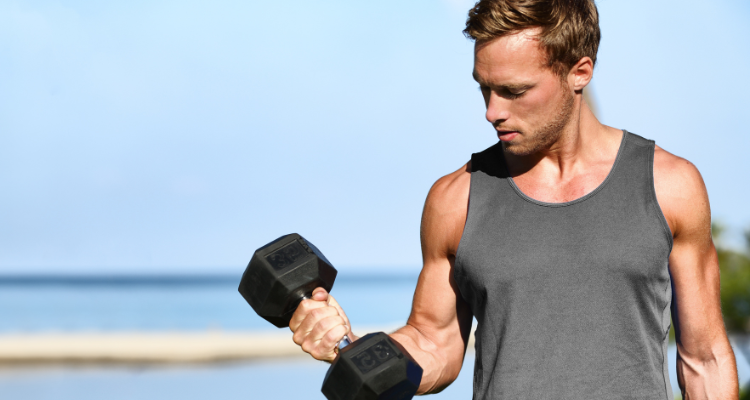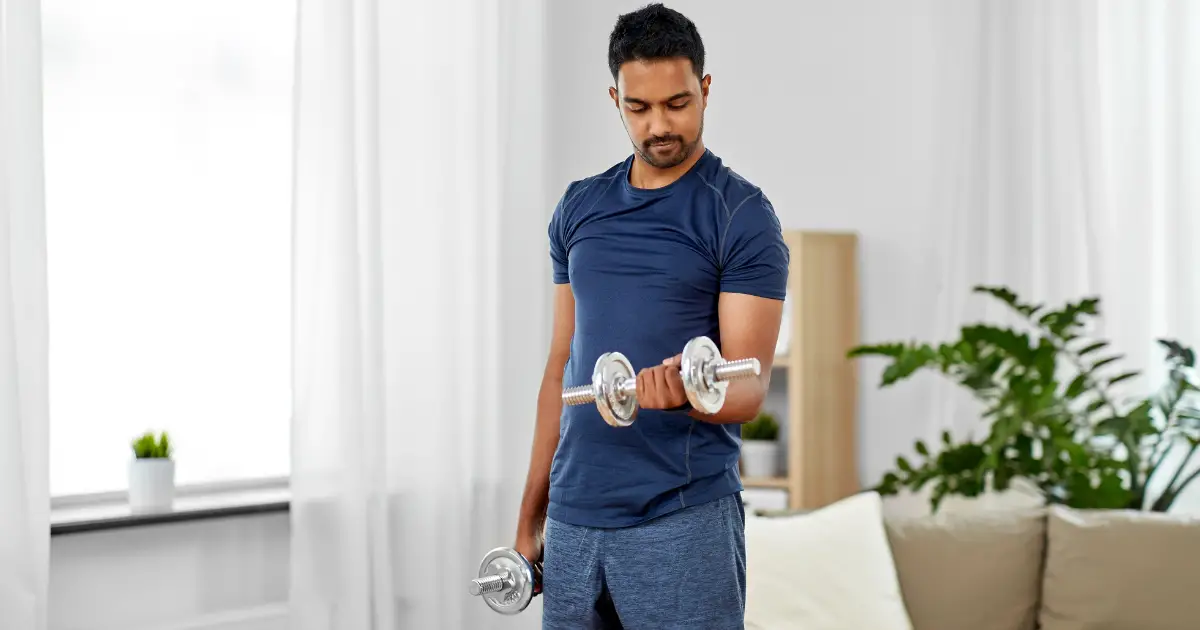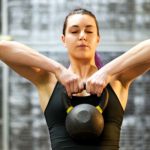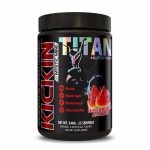For beginners, an effective arm workout routine should include exercises like bicep curls, tricep dips, and push-ups. These exercises target the muscles in the arms, helping to build strength and definition.
Incorporating a mix of compound and isolation exercises will provide a balanced workout that targets all areas of the arm. Starting with light weights and gradually increasing the intensity and weight will ensure gradual progression and avoid injuries. Consistency and proper form are key to achieving desired results.

Benefits Of Arm Workouts
Increased Strength And Muscle Tone
Building strength and muscle tone in your arms is one of the key benefits of incorporating arm workouts into your fitness routine. By engaging in targeted exercises that focus on your biceps, triceps, and shoulders, you can expect to experience significant increases in both strength and muscle definition.
Push-ups: Performing push-ups helps to strengthen the muscles in your chest, shoulders, and triceps. It is a compound exercise that also engages the core and improves overall upper body strength.
Bicep curls: By doing bicep curls with dumbbells or resistance bands, you can isolate and work the muscles in your biceps. This exercise helps to enhance arm strength and promote muscle growth.
Tricep dips: Tricep dips target the muscles located at the back of your arms and are great for building strength and toning. They can be done on parallel bars, a bench, or even the edge of a sturdy chair.
Improved Posture And Upper Body Stability
In addition to strengthening your arms, regular arm workouts can improve your posture and upper body stability. These exercises engage the muscles in your back, shoulders, and chest, helping you develop a more balanced and upright posture.
Shoulder presses: Performing shoulder presses with dumbbells or a barbell helps to strengthen your shoulder muscles, which play a crucial role in maintaining good posture. Strong shoulders provide stability to your upper body, reducing the risk of slouching or hunching.
Plank variations: Plank exercises target the core muscles as well as the muscles in your arms and shoulders. By strengthening these muscles, you can achieve better posture and upper body stability.
Rows: Rowing exercises, whether using resistance bands or a rowing machine, engage the muscles of the upper back and shoulders. Strengthening these muscles helps to counteract the effects of poor posture and promote a more aligned and stable upper body.
Boosted Metabolism And Fat Burn
Engaging in regular arm workouts not only helps to build strength and improve posture but also has the added benefit of boosting your metabolism and aiding in fat burn.
Compound exercises: Compound exercises, such as burpees or kettlebell swings, engage multiple muscle groups simultaneously, resulting in a higher calorie burn and increased metabolic rate.
High-intensity interval training (HIIT): Incorporating hiit exercises, like mountain climbers or jumping jacks, into your arm workout routine can help to elevate your heart rate and increase calorie burn, leading to fat loss.
Increased muscle mass: Building muscle through arm workouts can boost your metabolism since muscle tissue burns more calories at rest than fat tissue. As you gain lean muscle mass, your body becomes more efficient at burning calories throughout the day.
Remember, consistency is key when it comes to reaping the benefits of arm workouts. Aim for two to three sessions per week, focusing on a variety of exercises that target different muscle groups. With time and dedication, you’ll begin to see and feel the positive changes in your strength, muscle tone, posture, and overall fitness level.
Getting Started: Essential Equipment And Warm-Up
Whether you are a beginner or a seasoned fitness enthusiast, starting any new workout routine requires proper preparation. Before diving into your arm workouts, it’s important to ensure you have the right equipment and warm-up properly to prevent injuries and maximize your performance.
Here are some key points to keep in mind:
Selecting The Right Weights And Resistance Bands
- Choose weights that are appropriate for your current fitness level. Start with lighter weights and gradually increase the resistance as you gain strength and confidence.
- Resistance bands can be a great addition to your arm workout routine. They provide constant tension throughout the movement, challenging your muscles in a different way.
- Consider having a variety of weights and resistance bands available, allowing you to adjust the intensity of your workout and target different muscle groups effectively.
Dynamic Stretching For A Proper Warm-Up
- Before jumping into your arm exercises, it’s crucial to warm up your muscles and increase flexibility. Dynamic stretching is an excellent way to prepare your body for the upcoming workout.
- Dynamic stretches involve moving your joints and muscles through a full range of motion. This helps increase blood flow, loosen up tight muscles, and minimize the risk of injuries.
- Incorporate exercises like arm circles, shoulder rolls, and wrist rotations into your warm-up routine. Perform each movement smoothly and gradually, paying attention to any areas of tightness or discomfort.
Remember, taking the time to properly warm up and select the right equipment is essential for a successful arm workout. By following these guidelines, you’ll set yourself up for a safe and effective training session. Now that you’re ready let’s dive into some effective arm exercises for beginners!
Basic Arm Exercises For Beginners
If you’re new to arm workouts or just starting your fitness journey, incorporating basic arm exercises into your routine can help you develop strength and definition in your upper body. By targeting different muscle groups, these exercises will lay the foundation for more advanced workouts as you progress.
In this section, we’ll explore three essential arm exercises for beginners: bicep curls, tricep dips, and push-ups.
1. Bicep Curls: Targeting The Front Of The Upper Arm
Bicep curls are a fundamental exercise that primarily focuses on the bicep muscles located in the front of your upper arm.
To perform bicep curls, follow these steps:
- Stand with your feet shoulder-width apart, holding a dumbbell in each hand with your palms facing forward.
- Keep your upper arms stationary and slowly curl the weights towards your shoulders, contracting your biceps.
- Hold for a brief pause and then lower the weights back down to the starting position.
- Bicep curls can be performed with various types of resistance, such as dumbbells, resistance bands, or even household items like water bottles.
- Aim for 2-3 sets of 10-12 repetitions to begin with, gradually increasing the weight and intensity as you become more comfortable with the exercise.
2. Tricep Dips: Toning The Back Of The Upper Arm
Tricep dips primarily target the tricep muscles located at the back of your upper arm and are a fantastic exercise for toning and strengthening this area.
To perform tricep dips, follow these steps:
- Find a sturdy chair or bench and sit on the edge with your hands gripping the edge of the seat, fingers facing forward.
- Walk your feet forward and extend your legs, lifting your buttocks off the chair.
- Slowly lower your body by bending your elbows, keeping your back close to the chair.
- Once your arms reach a 90-degree angle, extend your elbows to return to the starting position.
- Start with 2-3 sets of 8-10 repetitions, focusing on maintaining proper form throughout the exercise.
- If you find the exercise too challenging, you can bend your knees or place your feet on the ground for additional support.
3. Push-Ups: Engaging The Entire Arm And Chest Muscles
Push-ups are a classic exercise that engage multiple muscle groups, including the arms, chest, and shoulders.
To perform push-ups, follow these steps:
- Start in a plank position with your hands slightly wider than shoulder-width apart, fingers pointing forward.
- Engage your core and lower your body by bending your elbows until your chest is just above the ground.
- Push through your palms to extend your arms and return to the starting position.
- If traditional push-ups are too challenging, you can modify the exercise by bending your knees and keeping them on the ground while performing the movement.
- Begin with 2-3 sets of 8-10 repetitions, gradually increasing the number of reps and sets as you gain strength.
- Push-ups can be adjusted to suit your fitness level, making them an excellent exercise for beginners looking to build upper body strength.
Incorporating these basic arm exercises into your workout routine will help you develop foundational strength in your upper body. Remember to start with a weight or difficulty level that challenges you without compromising your form. As you progress, gradually increase the intensity to continue challenging your muscles and achieving your fitness goals.
Advanced Arm Exercises For Progression
Arm workouts are a great way to sculpt and strengthen your upper body. Whether you’re a beginner looking to build some foundational strength or someone who’s been working out for a while and wants to level up, incorporating advanced arm exercises into your routine can help you achieve impressive results.
In this section, we’ll explore three advanced arm exercises that target different muscle groups for a well-rounded and challenging workout. Let’s dive in!
1. Hammer Curls: Building Overall Arm Strength And Definition
- Hammer curls effectively target both your biceps and forearms, helping you build overall arm strength and definition.
- This exercise is performed by holding a dumbbell in each hand with your palms facing your body, then curling the weights up towards your shoulders while keeping your wrists in a neutral position.
- Key points:
- Engage your biceps and forearms throughout the movement.
- Maintain proper form by keeping your elbows tucked in at your sides and avoiding swinging or using momentum.
- Start with lighter dumbbells and gradually increase the weight as you become more comfortable and stronger.
2. Skull Crushers: Targeting The Triceps For A Sculpted Look
- Skull crushers specifically target the triceps, helping you achieve a sculpted and toned appearance in the back of your arms.
- To perform this exercise, lie flat on a bench or mat with a dumbbell in each hand. Extend your arms up towards the ceiling, and then slowly bend your elbows, allowing the weights to lower towards your forehead. Finally, extend your arms back up to the starting position.
- Key points:
- Focus on the contraction of your triceps throughout the movement.
- Keep your elbows stationary, pointing towards the ceiling, and avoid letting them flare out to the sides.
- Start with a lighter weight and gradually increase as you gain strength and confidence in your form.
3. Diamond Push-Ups: Maximizing Muscle Engagement For Impressive Results
- Diamond push-ups are a challenging variation of the traditional push-up that maximizes muscle engagement in your arms and chest.
- To perform this exercise, assume a push-up position with your hands close together, forming a diamond shape under your chest. Lower your body towards the ground by bending your elbows, then push back up to the starting position.
- Key points:
- Keep your core engaged and your body in a straight line throughout the exercise.
- Focus on squeezing your triceps and chest as you push back up from the lowered position.
- If diamond push-ups are too challenging initially, start with modified push-ups on your knees and gradually progress to full diamond push-ups.
Incorporating these advanced arm exercises into your routine can take your upper body workout to the next level. Remember to start with proper form and gradually increase the intensity as you gain strength and confidence. Challenge yourself, stay consistent, and enjoy the journey to stronger and more sculpted arms!
Incorporating Compound Exercises For Full-Body Benefits
Arm Workout Routine For Beginners
If you’re new to working out and looking to get started on an arm workout routine, incorporating compound exercises is a fantastic way to maximize your full-body benefits. Compound exercises are movements that engage multiple muscle groups at once, providing a complete workout experience.
In this blog post, we’ll explore three compound exercises that are perfect for beginners: bent-over rows, overhead press, and plank with shoulder taps. Let’s dive in!
Bent-Over Rows: Engaging Multiple Muscle Groups For A Complete Workout
- Bent-over rows target and strengthen your back muscles, biceps, and core.
- Engaging in this exercise can improve your posture and help prevent back pain.
- To perform bent-over rows, hold a dumbbell or a barbell with an overhand grip, hinge at the hips, and bend your knees slightly. Keep your back straight and pull the weight towards your chest, squeezing your shoulder blades together.
Overhead Press: Strengthening The Shoulders And Arms Simultaneously
- Overhead press primarily targets the deltoid muscles in your shoulders and the triceps in your arms.
- This exercise improves shoulder stability and enhances upper body strength.
- To do the overhead press, stand tall with your feet hip-width apart and hold a dumbbell or a barbell at shoulder height. Press the weight overhead until your arms are fully extended, and then lower it back to the starting position.
Plank With Shoulder Taps: Combining Core Stability With Upper Body Toning
- Plank with shoulder taps is a fantastic exercise that targets your core muscles while also toning your shoulders, arms, and upper back.
- This exercise helps improve stability and overall body control.
- To perform plank with shoulder taps, start in a high plank position, making sure your body forms a straight line. While maintaining a stable core, lift one hand off the ground and tap the opposite shoulder. Repeat on the other side, alternating the taps while keeping your hips level.
Incorporating these compound exercises into your arm workout routine will not only help you build strength in your arms but also provide full-body benefits. Remember to start with lighter weights and focus on maintaining proper form and technique. With consistency and dedication, you’ll be on your way to achieving your fitness goals.
So, grab those dumbbells and get ready to work those arms!
Designing An Effective Arm Workout Routine
Designing an effective arm workout routine is crucial for beginners who want to build strength and muscle definition in their upper body. By setting specific goals, structuring workouts for optimal results, and incorporating rest days and recovery strategies, you can maximize your progress and avoid hitting a plateau.
In this section, we will explore these key components in detail.
Setting Specific Goals And Tracking Progress:
- Determine your specific arm-related goals, such as increasing muscle size, improving strength, or toning.
- Break down your goals into smaller, measurable targets to stay motivated and track your progress effectively. For example, aim to increase the number of push-ups or bicep curls you can do in a certain time frame.
- Keep a workout journal or use an app to record your exercises, sets, reps, and weights. This will help you monitor your improvements and make adjustments as needed.
Structuring Workouts For Optimal Results And Avoiding Plateau:
- Incorporate a mix of exercises that target different arm muscles, such as biceps, triceps, and shoulders. This will ensure balanced development and avoid muscle imbalances.
- Vary your routine by changing the number of sets, reps, and weights you use. This helps prevent your muscles from adapting to the same stimulus, which can lead to a plateau.
- Prioritize compound exercises, such as push-ups, pull-ups, and dips, as they engage multiple muscle groups simultaneously and promote overall arm strength.
- Gradually increase the intensity of your workouts over time by adding weight or increasing resistance. This progressive overload stimulates muscle growth and strength gains.
Incorporating Rest Days And Recovery Strategies:
- Rest days are essential for muscle repair and growth. Allow at least one or two days of rest per week to prevent overtraining and minimize the risk of injury.
- Consider incorporating active recovery activities on your rest days, such as light cardio or stretching, to promote blood flow and reduce muscle soreness.
- Adequate sleep is crucial for muscle recovery and overall well-being. Aim for 7-9 hours of quality sleep each night to optimize your arm workout results.
- Pay attention to your nutrition and hydration. Consuming a balanced diet with sufficient protein, carbohydrates, and healthy fats will support muscle repair and growth.
By designing an effective arm workout routine that includes specific goals, proper structuring, and proper rest and recovery, beginners can lay a solid foundation for their fitness journey. Remember to always listen to your body, make adjustments when necessary, and celebrate your progress along the way.
Tips For Proper Form And Injury Prevention
Maintaining correct posture and alignment during exercises:
- Keep your back straight and shoulders relaxed to avoid unnecessary strain.
- Engage your core muscles to stabilize your body throughout the movements.
- Ensure that your wrists, elbows, and knees are properly aligned to reduce the risk of injury.
- Avoid rounding your shoulders or arching your back, as this can put additional stress on your spine.
Gradually increasing intensity and weight to prevent strain:
- Start with lighter weights or resistance and gradually increase the load as your strength and technique improve.
- Avoid overexerting yourself or attempting to lift heavy weights beyond your capabilities.
- Allow your muscles to adapt and recover between workouts to prevent overuse injuries.
- Gradually increase the number of repetitions and sets as you progress, rather than trying to do too much too soon.
Listening to the body and seeking professional guidance when needed:
- Pay attention to how your body feels during and after exercise. If you experience pain or discomfort, adjust your form or modify the exercise as necessary.
- Rest when needed to allow your muscles time to recover and prevent overtraining.
- If you’re unsure about proper form or techniques, consider seeking guidance from a certified fitness professional or instructor to ensure you’re performing the exercises correctly and safely.
- Remember, it’s better to take things slowly and prevent injuries than to push through and worsen an existing condition.
Maintaining proper form and gradually increasing the intensity of your arm workout routine are crucial factors in injury prevention. Listening to your body and seeking professional guidance when needed will also play a significant role in keeping you safe and on track with your fitness goals.
By following these tips, you can avoid injuries and make progress in your arm strength and muscular development.
Sample Arm Workout Routine For Beginners
Warm-Up: Dynamic Stretching And Light Cardio
To ensure you have a safe and effective arm workout, it’s crucial to start with a proper warm-up. This will prepare your muscles, joints, and cardiovascular system for the upcoming exercises. A well-rounded warm-up should consist of dynamic stretching and light cardio activities.
Here’s a sample warm-up routine for beginners:
- Begin with a 5-minute brisk walk or light jogging to elevate your heart rate.
- Follow this with dynamic stretches that target your arms, such as arm circles, shoulder rolls, and wrist rotations. Perform each stretch for 10-15 seconds and repeat for 2-3 sets.
Exercise Circuit: Incorporating A Mix Of Basic And Advanced Arm Exercises
Now that your muscles are warmed up, it’s time to move on to the main part of your arm workout – the exercise circuit. This routine combines a mix of basic and advanced arm exercises to challenge and strengthen your muscles.
Here’s a sample arm workout routine for beginners:
Bicep curls: Hold a pair of dumbbells with your palms facing forward, then curl your arms upward, squeezing your biceps at the top. Aim for 3 sets of 10-12 repetitions.
Tricep dips: Sit on the edge of a bench or chair, grip the edge with your hands shoulder-width apart, and extend your legs out in front of you. Lower your body by bending your elbows, then push back up to the starting position. Aim for 3 sets of 8-10 repetitions.
Push-ups: Begin in a high plank position with your hands slightly wider than shoulder-width apart. Lower your body by bending your elbows, then push back up. Modify the exercise by performing push-ups on your knees if needed. Aim for 3 sets of 8-12 repetitions.
Hammer curls: Hold a pair of dumbbells with your palms facing each other, then curl your arms upward, keeping your palms facing inward throughout the movement. Aim for 3 sets of 10-12 repetitions.
Tricep kickbacks: Hold a dumbbell in one hand, hinge forward at the hips, and extend your arm back, squeezing your tricep at the top. Repeat on the other side. Aim for 3 sets of 8-10 repetitions per arm.
Cool-Down: Stretching And Foam Rolling For Muscle Recovery
After completing the exercise circuit, it’s essential to cool down and promote muscle recovery. This will help prevent post-workout soreness and stiffness. Here’s a sample cool-down routine for beginners:
- Perform static stretches for your arms, such as tricep stretches and bicep stretches, holding each stretch for 15-30 seconds.
- Incorporate foam rolling to release any tension in your arm muscles. Roll the foam roller gently up and down your arms, applying light pressure.
Remember to listen to your body throughout the warm-up, exercise circuit, and cool-down. If you experience any pain or discomfort, modify or discontinue the exercises accordingly. With regular practice and consistency, this arm workout routine for beginners will help you build strength and tone your arm muscles.
Get ready to flex those biceps!
Schedule And Frequency For Arm Workouts
Finding A Balance Between Workout Days And Rest Days
When it comes to arm workouts, finding the right schedule and frequency is crucial for beginners to see progress without overtraining. Establishing an effective routine ensures that you give your muscles enough time to recover and grow stronger. Here are some key points to consider when planning your arm workout schedule:
Start slow: As a beginner, it’s important to ease into your arm workout routine. Pushing yourself too hard too soon can lead to overtraining and potential injuries. Gradually increase the intensity and duration of your workouts as your strength and stamina improve.
Listen to your body: Pay attention to how your body feels after each arm workout. If you experience excessive soreness or fatigue, it may be a sign that you need more rest days in your schedule. On the other hand, if you feel like you could do more, it might be an indication to increase the frequency of your workouts.
Alternate muscle groups: To avoid overworking your arm muscles, incorporate rest days in your schedule or focus on different muscle groups on alternate days. This allows your arm muscles to recover while you work on other areas of your body, creating a balanced workout routine.
3-4 workouts per week: For beginners, aiming for around 3 to 4 arm workouts per week is a good starting point. This frequency gives your muscles enough stimulus to grow stronger and allows for adequate recovery time between sessions. Remember, quality workouts are more important than quantity.
Rest and recovery: Rest days are just as important as workout days. Make sure to incorporate at least 1 or 2 rest days in your weekly routine to allow your muscles to repair and rebuild. During rest days, focus on stretching, foam rolling, and other recovery practices to enhance muscle recovery and prevent injury.
Monitor progress: Regularly assess your progress and adjust your schedule accordingly. If you find that you are not making any gains or are experiencing excessive fatigue, it may be necessary to reduce the frequency of your arm workouts. On the other hand, if you are progressing well, you can gradually increase the number of workouts per week.
By finding the right balance between workout days and rest days, you can maximize the effectiveness of your arm workout routine. Remember to listen to your body, be consistent, and give yourself enough time to recover and grow stronger. With a well-planned schedule and the right frequency, you’ll be well on your way to sculpting strong and toned arms.
Frequently Asked Questions
How Often Should I Do Arm Workouts As A Beginner?
As a beginner, it’s recommended to do arm workouts 2-3 times per week to allow enough time for rest and recovery.
What Are Some Basic Arm Exercises For Beginners?
Some basic arm exercises for beginners include bicep curls, tricep dips, push-ups, and overhead press with dumbbells.
Can I Use Resistance Bands Instead Of Weights For Arm Workouts?
Yes, resistance bands can be a great alternative to weights for arm workouts, providing similar resistance and allowing for a versatile range of exercises.
How Long Should A Beginner Arm Workout Session Last?
A beginner arm workout session should typically last around 20-30 minutes, focusing on proper form and gradually increasing intensity over time.
Is It Normal To Feel Sore After Arm Workouts?
Yes, it’s normal to feel some soreness in your arms after workouts, especially as a beginner. This indicates that your muscles are adapting and getting stronger.
Conclusion
If you’re a beginner looking to start an arm workout routine, it’s important to remember that consistency and gradual progression are key. By following the exercises outlined in this blog post, you can begin building strength and toning your arms effectively.
Start with lighter weights and focus on proper form to avoid injury. As you gain confidence and strength, gradually increase the weight and intensity of your workouts. Don’t forget the importance of variety in your routine – incorporating different exercises and equipment can target different muscle groups and keep your workouts interesting.
Remember to listen to your body and give yourself rest days to allow for muscle recovery. With dedication and perseverance, you can achieve your desired arm strength and definition. So, grab those dumbbells and get started on your arm workout journey today!





